Maintenance and care
More recently, it was believed that "Linden's Dendrofilax" is a parasite and absorbs nutrients and moisture from the tree on which it grows. But scientists managed to prove that the "Ghost" orchid enters into symbiosis with a certain type of fungus - mycorrhiza and due to this it exists. They managed to infect the seeds with this fungus and get the first shoots in the laboratory.
When the grown seedlings were transplanted into the natural environment, the result was impressive. About 80% of the seedlings have taken root. Currently, this rare species is successfully cultivated in the Botanical Gardens of Naples and Florida. There is even data on cultivation in other countries.
This may mean that, in principle, having infected seeds or strains of the fungus, you can, having created the necessary conditions and care, try to grow it at home.
Optimal growing conditions
If it was possible to find "Linden's Dendrofilax", then in no case should its root system be disturbed. An attempt should be made to remove the orchid along with the bark, moss, and all the substrate on which it grew. This complex is fixed on a block and placed in a special terrarium with bark, sphagnum moss.
Provided by:
- scattered light input;
- humidity under 80%;
- insignificant and rare airing.
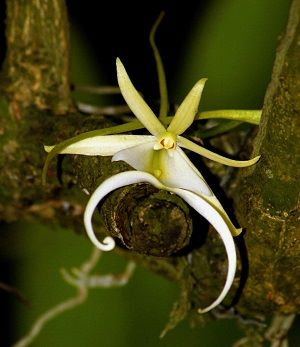 Also protect the plant from possible cold in winter. It is required to create conditions close to natural. In a terrarium environment, this can be done, although the survival rate is quite low.
Also protect the plant from possible cold in winter. It is required to create conditions close to natural. In a terrarium environment, this can be done, although the survival rate is quite low.
In the warm season, you should adhere to a certain temperature regime with a daily fluctuation from 8 to 11 °. The optimal daytime temperature should be about 30-33 ° C, respectively, the nighttime 20-23 ° C.
In the cold season, when a dormant period occurs, the temperature regime should be with daytime, 25-26 ° C and night, about 12-13 ° C.
In nature, the "Ghost" can grow in a fairly large temperature range. The minimum for it is considered to be up to -3 °, and the maximum is not more than + 40 °.
Airing is extremely rare, since in the nature of swampy areas, high humidity with stagnant air is characteristic.
Features of watering and additional power
Watering is done on a regular, weekly basis, with soft (preferably rain or melt) water.
Important! Overflow and drying of roots are not allowed. They should be constantly moist, but not wet .. Reduction of watering and fertilizing occurs during periods of dormancy, which begins in late autumn and continues until early spring
A reduction in watering and fertilizing occurs during periods of dormancy, which begins in late autumn and continues until early spring.
Food is combined with watering. At the same time, every third watering is supplemented with a 3-4 times reduced dose of fertilizers from the recommended by the manufacturer. They mainly use special fertilizers for epiphytes or orchids.
Prevention of diseases and pests
Prevention, like most plants, mainly consists in creating the necessary conditions and proper care.
The exceptional rarity of "Dendrofilax Linden" does not make it possible to carry out any analysis of diseases. Therefore, if an enthusiastic florist tries to cultivate such exoticism, he relies only on his experience, knowledge and flair.
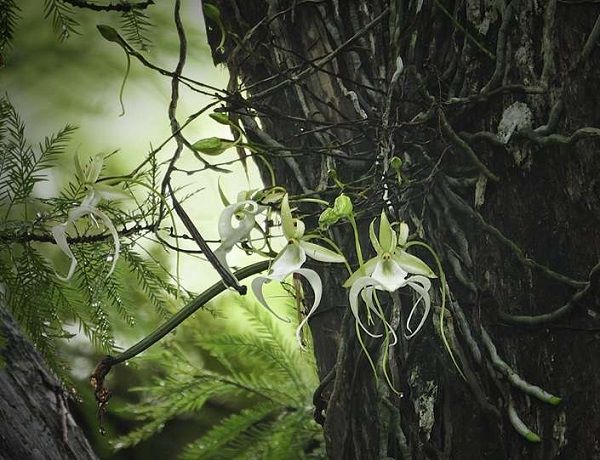
Diseases of the Ghost Orchid are very little studied.
Nuances of choice
Florists recommend buying orchids during their flowering period. Blooming flowers attract potential buyers with their appearance. Due to the special shape of the flower, customers do not pay attention to defects that would be worth checking.To get a healthy, strong flower for a long time, there is a lot to test.
- The roots of the plant must be firmly attached to the substrate. After chatting it in the planting container, there should be no signs of the plant deviating from its direction.
- Phalaenopsis leaves should have volume, impressive veins and a strong integumentary tissue. The presence of gloss on the leaves is an indicator of the health of the plant. And also it should not have dried ends, look flaccid.
- Phalaenopsis flowers should not show signs of decay, a bright color and reliable fixation of the inflorescence on the stalk is encouraged.
Transplanting a plant after shopping in a store
A store-bought orchid must be transplanted from a temporary container into a permanent pot. At the same time, the entire temporary substrate is completely replaced, leaving only an earthen lump on the roots. An actively flowering plant does not need to be transplanted immediately, this will lead to the fall of the buds.
A plant without flowers is transplanted into a permanent pot. Phalaenopsis peloric orchid tolerates a transplant well. The main thing is to choose a high-quality substrate for it.
The flower is carefully removed from the temporary pot, the roots are carefully examined. If there are rotten areas, they must be removed.
The cut sites are treated with crushed activated carbon.
Then carefully lower the orchid root system into a new pot, carefully straightening the roots so that they do not bend. Pour a damp substrate into the pot and place the plant for acclimatization. Watering is stopped for two weeks, and the flower pot is placed in a cool, shaded place.
History of appearance
 Blue orchids are no coincidence. The market and the consumer prompts and dictates the conditions:
Blue orchids are no coincidence. The market and the consumer prompts and dictates the conditions:
- How are blue phalaenopsis grown? But in any way - they are painted;
- Phalaenopsis does not have blue genes that provide such a pigment, scientists say. Other orchids have;
- We must create!
- And we are witnesses of their appearance and development. Note that dyed orchids of various colors have been on sale on the market for a long time.
Almost at the same time in 2011, the most important events in the history of these plants took place. January. Exhibition of tropical plants. Fort Lauderdale:
-
Silver Vase Farm has been growing orchids in South Florida for over 20 years. At the exhibition, they show blue Phalaenopsis - Blue Mystique (Blue mystic);
- On their website, they claim that there are no such blues. He is the first. Its website claims to be the first. What way he was raised, they do not inform.
In Holland, the Flora Holland flower auction is held in May. It is held annually and is prestigious in the world of flowers. Phalaenopsis Royal Blue was named first in the Sales Concept category:
- The Glass Tulip Award went to Marketing Achievement;
- The authors are a family nursery from the Dutch town of De Lier. Specializes in the cultivation of orchids;
- They are predicted to be successful. And so it happened;
- The creators do not particularly reveal their technology of growing them;
- They even warn. They will not be blue in the second bloom. They will be white. And it is written on the tags (labels). As on the website;
- He is not the only one. The collection of grown orchids by this method has been created since 2009 (salad, purple, bluish). And with their own names. Blue turned out to be the best choice;
- The Americans' results were more modest. Only out of three color options.
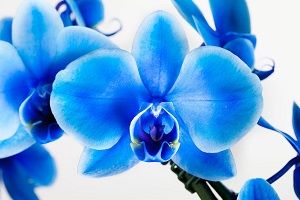 Europeans do not have such an enthusiastic demand for colored flowers. This is what their experts and experts say:
Europeans do not have such an enthusiastic demand for colored flowers. This is what their experts and experts say:
- They consider this to be a good result;
- Successful marketing ploy;
- And an incomparable one-time gift (bouquet).
Only in our endless expanses there is no such tranquility. The psychosis has subsided, but the demand has not diminished.
Among orchids, there are enough species with other colors with the participation of blue.
Lovers of orchids with blue colors are advised to pay attention to the Wanda or Cattleya orchids.Also on our website you can see a selection of blue orchids here and here
They are admirable:
Wanda. Bluish lilac or purple in color. And light dots. Subsequent flowering will be with the same flowers;
Wanda.
Important! She is picky about leaving. Few experienced florists can provide her with their own microclimate.
Only daily watering is worth it.
Cattleya. Just look at these beauties. Quite large flowers. Fragrant. And more affordable in care.
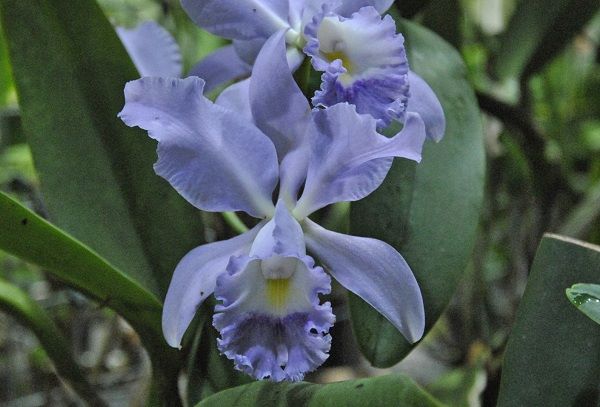
Cattleya.
Home care
Optimal conditions of detention
The hybrid was bred for cultivation in a living room; greenhouse conditions do not need to be created. The light should be bright, but diffused - this is exactly the kind of lighting in the depths of the tropical jungle, in the homeland of orchids.
It is necessary to protect the green sissy in summer from sunburn, and in winter - from freezing on a cold windowsill.
The plant should be kept clean, protected from dust and occasionally sprayed. The optimum temperature is + 22̊С, with a 5-10̊С decrease at night.
The first flower arrows appear when the plant is fully developed, gaining strength. Signs of imminent flowering can be:
- the plant is at least two years old;
- the leaves look fresh and firm, the color is bright and rich, there are at least four of them;
- the roots are clean and healthy;
The season doesn't really matter.
Transfer after purchase in the store
Important! Transplanting a blooming orchid will only harm the plant. Wait for the transition to the dormant period .. The transplant is needed mainly in order to examine the root system of the plant.
To preserve moisture, pieces of sponge, sphagnum moss are placed among the roots - these materials must be carefully selected and removed from the roots. They have already played their role in the transportation and preservation of moisture and for a longer time can only harm due to the formation of mold.
The transplant is needed mainly in order to examine the root system of the plant. To retain moisture, pieces of sponge, sphagnum moss are placed among the roots - these materials must be carefully selected and removed from the roots. They have already played their role in the transportation and preservation of moisture and can only do much harm for longer due to the formation of mold.
It is necessary to remove diseased roots. Black, brown areas, as well as dried ones, are cut off with a sharp, clean knife to a living green tissue, the cut is sprinkled with crushed charcoal (activated from the first-aid kit).
A transparent pot is filled with soil for orchids up to a third of its volume, then the plant is carefully placed and gradually the rest of the pot is filled with soil. The soil should "hold" the flower, preventing it from loosening in the pot.
Phalaenopsis transplant.
During the industrial cultivation of plants, they are intensively fed and stimulate growth and flowering. After the purchase, you need to continue regular fertilization, otherwise the plant will "starve" and may even shed its buds.
Flowering time and dormant period at home
One of the distinctive features of this type of phalaenopsis is the absence of a pronounced dormant period and the ability to bloom almost all year round.
Watering and feeding
Water for irrigation should be of good quality, room temperature. Let's admit watering with warm water.
Liquid complex fertilizer for orchids is dissolved in water for irrigation and the pot is immersed in a container with water for -2 minutes. The water should drain freely from the roots to avoid root rot.
Stimulating flowering
Such a common method as stimulating dormant buds in phalaenopsis with cetokinic acid, with multiflora, is useless, since this paste is applied to the dormant kidneys. And the flower buds of these hybrids are located among the root system and are not available for paste application.
To stimulate flowering, from the available methods, the general healing of the plant remains, including with the help of fertilizers. Succinic acid and epin are suitable.
Pruning after flowering
After the end of flowering, you must trim the branch above the second flower bud.If the plant is well developed, it is possible, after a dormant period, a new peduncle will grow from this bud.
Prevention of diseases and pests
In order for the plant to remain healthy, you need to create the most comfortable living conditions for it. To prevent diseases and pests, new plants brought into the house are quarantined for the first month. Never take the orchid out onto the open balcony, there you can easily pick up some kind of living creatures.
Attention! Multi-flowered hybrids develop powerful flower stalks, abundantly dotted with flowers. This flower mass can be quite heavy.
If the pot is too small and light, the orchid can fall off and be seriously damaged. This is a strong case for a glass pot.
Northern varieties of wild plants
Amateur gardeners often wonder if these delightful plants can be transferred to their backyard plot. Let them delight the eye in flower beds or beds!
Attention! Perhaps it would be very cool to grow calypso or lyubka on your own. Unfortunately, this is extremely difficult.
Connoisseurs of botany are aware that all members of the orchid family are extremely capricious creatures.
And even northern flowers, despite their frost resistance, are extremely demanding on growing conditions. They need exactly those indicators of temperature, humidity, etc., in which they grow! As a rule, these are the surroundings of small bogs or peat bogs, lowlands, humid areas in shaded meadows in deep forests. It is extremely difficult to create such conditions in the garden.
There are several types of wild orchids that can grow in summer cottages (but not at home). Among them:
- finger-root;
- garden variety of the Venus shoe;
- slumber.
Dremlik grows well in the garden. He loves partial shade, so he will be fine under the canopy of trees.
Varieties of Celogin's orchid
Kristata
One of the most popular for indoor cultivation is the Celogin Christata or Comb orchid. The place of growth of this beauty is the Himalayas. Differs in rounded bulbs with a pair of belt-like leaves.
On a peduncle, which grows up to 30 cm, there are from 3 to 10 buds, which open in flowers with a diameter of about 8 cm. The characteristic three-lobed lip stands out with an orange-yellow spot. Flowering begins in the first month of the year and lasts about one and a half months.
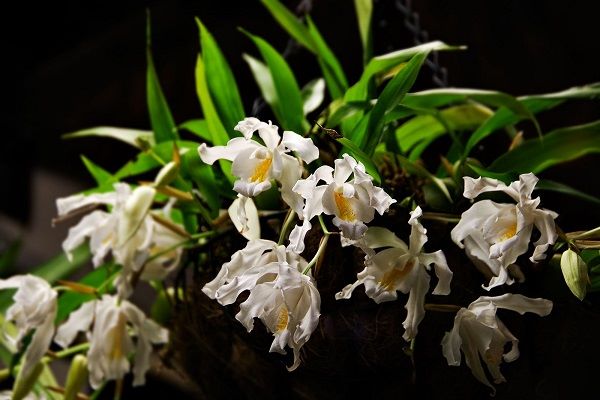
Kristata.
Massange
A thermophilic inhabitant of the Malay archipelago with a bulb length of 10-12 cm. The leaves are rather long, with noticeable venation. The flowering arrow reaches almost 60 cm, with numerous, from 15 to 20 cream-colored flowers.
The diameter of the flowers is about 5 cm. The sepals of the flower cover a wide lip. The lip has a three-lobed ocher color, with a yellow spot at the bottom. This orchid can bloom up to 3 times a year with several peduncles at once. The flowering time is May or June, with a duration of about two weeks.

Massange.
Flacida or drooping
A compact orchid with elongated pseudobulbs and a long drooping peduncle. Hence the name - Poniklaya. Leaves are bright green, lanceolate, growing 2 pieces on each bulb.
On the flowering arrow, about 9-15 fragrant flowers are formed, with a diameter of 3-4 cm. A lip with 3 ridges and orange-yellow spots. The flowering period is from December to May. The main peak falls on the month of March.
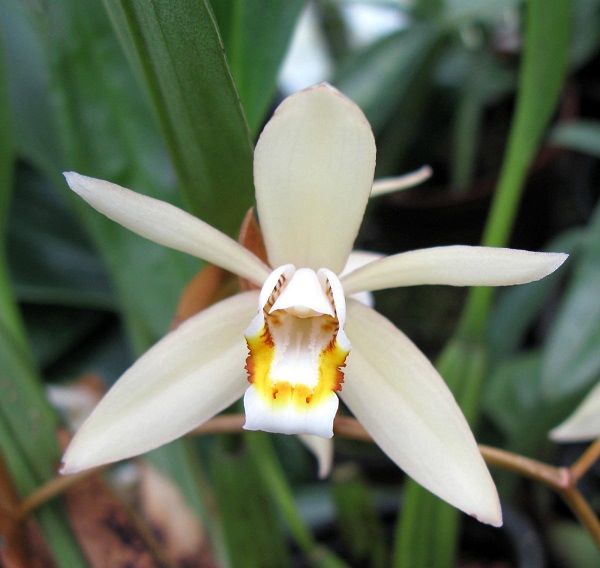
Flacida.
Pandurat
The leaves are folded, belt-like and 40-45 cm long, emerging from the bulbs, oblong up to 10 cm. Flowering peduncle, forming about 10 large flowers, with creamy green sepals.
Wide lip, with fringed combs and prominent brown or black spots. Pandurata loves warmth and blooms in the summer, usually in June-July.

Pandurat.
Speciosa or beautiful
Small, compact orchid with dense green growth. The leaves are short, oblong, light green in color. The flowering arrows are also not impressive in height. They are short and form 1-2 buds in total.
The flowers are yellowish-green, about 6 cm in diameter, with a large and wide lip, on which there is a yellow spot with red-brown tappings. It blooms almost all year round with an autumn peak.

Speciosa.
Varieties of the Cattleya cultivar
Petals:
- Raspberry;
- Thin;
- Curved.
Luxurious lip with deep purple color.

Eclipse.
A spectacular raspberry hybrid with a bright orange lip. Fast growing hybrid.
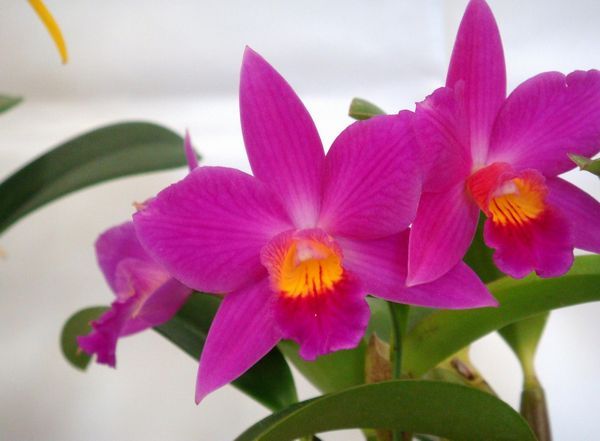
Cattleya Miyuki Little King.
Earl "Imperials"
Simple classic color - white with yellow in the middle. The structure of the flower is typical for Cattleya - delicate double petals of complex shape, pronounced spectacular lip.
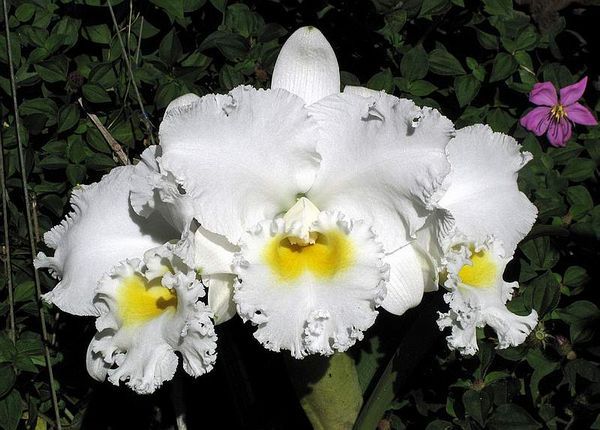
Cattleya Earl 'Imperialis'.
X venosa
The original color of the petals of a greenish-lemon shade successfully emphasizes a small lip of a refined lavender color with a bright yellow core. The edges are decorated with delicate ripple.

Cattleya x venosa (Forbesii X Harrisoniae).
Margaret Degenhardt "Saturn"
Terry petals of cosmic color:
- The main background is pink;
-
The lip is contrasting purple;
- Sunny yellow center;
- And rays on the sepals.


